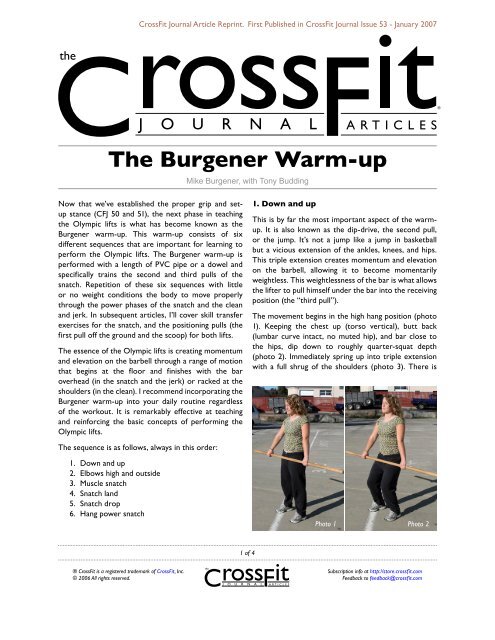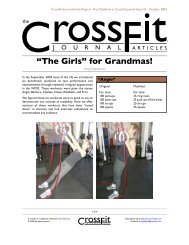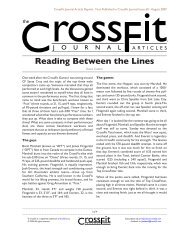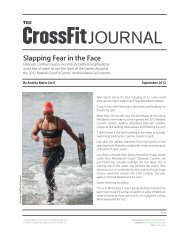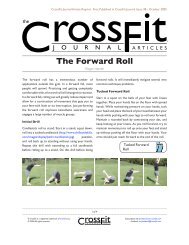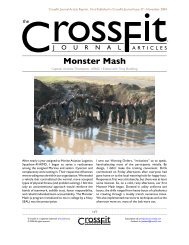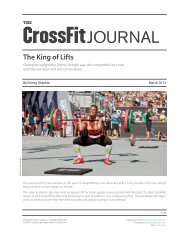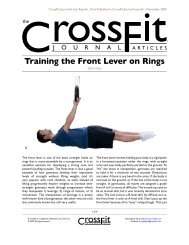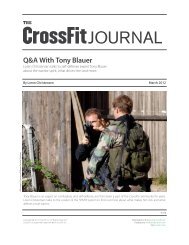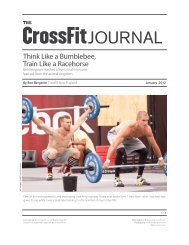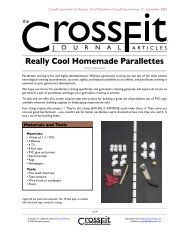You also want an ePaper? Increase the reach of your titles
YUMPU automatically turns print PDFs into web optimized ePapers that Google loves.
® <strong>CrossFit</strong> is a registered trademark of <strong>CrossFit</strong>, Inc.<br />
© 2006 All rights reserved.<br />
<strong>CrossFit</strong> Journal Article Reprint. First Published in <strong>CrossFit</strong> Journal Issue 53 - January 2007<br />
<strong>The</strong> <strong>Burgener</strong> <strong>Warm</strong>-<strong>up</strong><br />
Now that we’ve established the proper grip and set<strong>up</strong><br />
stance (CFJ 50 and 51), the next phase in teaching<br />
the Olympic lifts is what has become known as the<br />
<strong>Burgener</strong> warm-<strong>up</strong>. This warm-<strong>up</strong> consists of six<br />
different sequences that are important for learning to<br />
perform the Olympic lifts. <strong>The</strong> <strong>Burgener</strong> warm-<strong>up</strong> is<br />
performed with a length of PVC pipe or a dowel and<br />
specifically trains the second and third pulls of the<br />
snatch. Repetition of these six sequences with little<br />
or no weight conditions the body to move properly<br />
through the power phases of the snatch and the clean<br />
and jerk. In subsequent articles, I’ll cover skill transfer<br />
exercises for the snatch, and the positioning pulls (the<br />
first pull off the ground and the scoop) for both lifts.<br />
<strong>The</strong> essence of the Olympic lifts is creating momentum<br />
and elevation on the barbell through a range of motion<br />
that begins at the floor and finishes with the bar<br />
overhead (in the snatch and the jerk) or racked at the<br />
shoulders (in the clean). I recommend incorporating the<br />
<strong>Burgener</strong> warm-<strong>up</strong> into your daily routine regardless<br />
of the workout. It is remarkably effective at teaching<br />
and reinforcing the basic concepts of performing the<br />
Olympic lifts.<br />
<strong>The</strong> sequence is as follows, always in this order:<br />
1.<br />
2.<br />
3.<br />
4.<br />
5.<br />
6.<br />
Down and <strong>up</strong><br />
Elbows high and outside<br />
Muscle snatch<br />
Snatch land<br />
Snatch drop<br />
Hang power snatch<br />
Mike <strong>Burgener</strong>, with Tony Budding<br />
of 4<br />
1. Down and <strong>up</strong><br />
This is by far the most important aspect of the warm<strong>up</strong>.<br />
It is also known as the dip-drive, the second pull,<br />
or the jump. It’s not a jump like a jump in basketball<br />
but a vicious extension of the ankles, knees, and hips.<br />
This triple extension creates momentum and elevation<br />
on the barbell, allowing it to become momentarily<br />
weightless. This weightlessness of the bar is what allows<br />
the lifter to pull himself under the bar into the receiving<br />
position (the “third pull”).<br />
<strong>The</strong> movement begins in the high hang position (photo<br />
1). Keeping the chest <strong>up</strong> (torso vertical), butt back<br />
(lumbar curve intact, no muted hip), and bar close to<br />
the hips, dip down to roughly quarter-squat depth<br />
(photo 2). Immediately spring <strong>up</strong> into triple extension<br />
with a full shrug of the shoulders (photo 3). <strong>The</strong>re is<br />
Photo Photo 2<br />
Subscription info at http://store.crossfit.com<br />
Feedback to feedback@crossfit.com
<strong>The</strong> <strong>Burgener</strong> <strong>Warm</strong>-Up (continued...)<br />
no hesitation at the bottom of the dip, just as there<br />
is no hesitation of a bouncing ball on the ground. This<br />
eccentric (downward) contraction is an elastic storing<br />
of energy prior to the concentric (<strong>up</strong>ward) action on<br />
the barbell. This is the jumping action that I constantly<br />
stress when teaching the Olympic lifts.<br />
2. Elbows high and outside<br />
® <strong>CrossFit</strong> is a registered trademark of <strong>CrossFit</strong>, Inc.<br />
© 2006 All rights reserved.<br />
http://media.crossfit.<br />
com/cf-video/Down-<br />
Up.wmv<br />
In the snatch and clean, the arms do not bend until after<br />
completion of the down and <strong>up</strong> portion of the lift. <strong>The</strong><br />
arms are much weaker than the hips, legs, and traps, and<br />
bending them early limits the power that can be applied<br />
to the bar. This second sequence in the <strong>Burgener</strong> warm<strong>up</strong><br />
mimics the <strong>up</strong>per-body movement in the beginning<br />
of the third pull (which will be covered in fuller detail<br />
later). Keeping the elbows high and outside allows the<br />
bar to remain close to the body during the third pull.<br />
<strong>The</strong> irony of this sequence is that the bar is never<br />
actually pulled <strong>up</strong> like this by the arms in any of the<br />
Olympic lifts. Instead, the elbow movement (high<br />
and outside) contained in this sequence is part of the<br />
process of pulling the body under the barbell, which<br />
has been made momentarily weightless by the force of<br />
the second pull. I include this movement in the warm<strong>up</strong>,<br />
however, because it trains for a more efficient pull.<br />
Problems arise when a lifter does not keep the bar<br />
2 of 4<br />
close (usually caused by having the elbows down and<br />
in rather than high and outside) or swings the bar away<br />
from the body (in which case the elbows are typically<br />
too straight). Practicing elbows high and outside daily<br />
creates a mindset of keeping the bar close to the body<br />
while performing the lifts.<br />
<strong>The</strong> movement begins exactly the same as the previous<br />
one, with the down and <strong>up</strong>. From the high hang position<br />
(photo 1), keeping the chest <strong>up</strong> (torso vertical), butt<br />
back (lumbar curve intact, no muted hip), and bar close<br />
to the hips, dip down to roughly quarter-squat depth<br />
(photo 2). Immediately spring <strong>up</strong> into triple extension<br />
with a full shrug of the shoulders (photo 3) and, this<br />
time, pull the elbows <strong>up</strong> high and outside (photo 4), like<br />
a scarecrow. <strong>The</strong>re is no hesitation at the bottom of<br />
the dip/down, nor is there any noticeable distinction<br />
between the shrug and the elbows rising (though they<br />
do occur in that order).<br />
3. Muscle snatch<br />
http://media.crossfit.<br />
com/cf-video/Elbows.wmv<br />
<strong>The</strong> end of the third pull of the snatch moves the barbell<br />
from in front of the chest to locked overhead. <strong>The</strong><br />
muscle snatch is an <strong>up</strong>per-body strengthening exercise<br />
that teaches the <strong>up</strong>per body portion of the third pull,<br />
focusing on the pull under and the receiving position.<br />
It is an extension of the previous sequence in which<br />
Photo 3 Photo 4 Photo 5 Photo 6<br />
Subscription info at http://store.crossfit.com<br />
Feedback to feedback@crossfit.com
<strong>The</strong> <strong>Burgener</strong> <strong>Warm</strong>-Up (continued...)<br />
the barbell is pulled <strong>up</strong> into the finishing position over<br />
the head (photo 5) after the elbows have come high<br />
and outside. <strong>The</strong>re is no rebending of the knees when<br />
solidifying the bar overhead. This is an <strong>up</strong>per-body<br />
strengthening exercise to focus on pulling one’s body<br />
under the bar.<br />
In the snatch, the bar basically becomes weightless at the<br />
end of the second pull (the down and <strong>up</strong>). <strong>The</strong> elbows go<br />
high and outside during the first phase of the third pull<br />
as the hips retreat and the body begins to descend. This<br />
is performed with all the gusto possible, as is the final<br />
pull-under, which finishes with the bar locked overhead.<br />
It is for learning this aggressive pull-under that I teach<br />
the muscle snatch.<br />
<strong>The</strong> bar is taken from the high hang when first learning<br />
the muscle snatch and then later from the floor as<br />
proficiency is established. <strong>The</strong> muscle snatch is one of<br />
my favorite exercises when strengthening the body for<br />
the competition snatch.<br />
4. Snatch land<br />
® <strong>CrossFit</strong> is a registered trademark of <strong>CrossFit</strong>, Inc.<br />
© 2006 All rights reserved.<br />
http://media.crossfit.<br />
com/cf-video/MuscleSnatch.wmv<br />
Snatch lands are used right after the muscle snatch to<br />
train the proper receiving position for the snatch. In this<br />
warm-<strong>up</strong>, we land in the quarter-squat position. This<br />
movement can also be done landing in the full squat<br />
position.<br />
<strong>The</strong> movement begins with the bar locked overhead in<br />
the frontal plane and held with a snatch grip. With a<br />
slight dip-drive of the hips and knees, the lifter heaves<br />
the bar <strong>up</strong>ward while quickly pulling his body down<br />
under the bar into a quarter-squat position (photo 6).<br />
Receiving the bar in this quarter-squat position actually<br />
familiarizes the lifter with receiving the bar in a power<br />
position. Note we are taking each step of the snatch in<br />
sequence. Learning how and where to receive the bar is<br />
the critical lesson when using snatch lands.<br />
http://media.crossfit.<br />
com/cf-video/Lands.wmv<br />
3 of 4<br />
5. Snatch drop<br />
<strong>The</strong> snatch drop is a variation of the snatch land that<br />
omits the initial dip and lands in a full squat position. To<br />
begin, the lifter locks the bar overhead in the frontal<br />
plane, pushing <strong>up</strong> on the barbell, arms locked and tight.<br />
With a tight core, she drops into a full squat position.<br />
No heave, just a drop from the standing position<br />
(photo 7). Footwork here is critical. <strong>The</strong> feet are in the<br />
jumping position at the start, just beneath the hips. On<br />
command, the lifter drops directly into the full-squat<br />
landing position. Notice that I did not say “the lifter<br />
drops into a quarter squat and then rides it down to<br />
the bottom.” <strong>The</strong> lifter should land as low as possible,<br />
with the body strong and tight. Speed, explosiveness,<br />
and tightness (muscle tension throughout the body) are<br />
critical in snatch drops.<br />
6. Hang power snatch<br />
Photo 7<br />
http://media.crossfit.<br />
com/cf-video/Snatch-<br />
Drops.wmv<br />
Now it’s time to put it all together and power snatch<br />
the barbell. <strong>The</strong> simple instructions are to jump<br />
the barbell <strong>up</strong> and then land with it overhead. More<br />
thoroughly: starting in the high hang position, jump the<br />
barbell through the full range of motion and land in the<br />
quarter-squat position with the bar locked overhead.<br />
This incorporates the down and <strong>up</strong> with a full shrug and<br />
Subscription info at http://store.crossfit.com<br />
Feedback to feedback@crossfit.com
<strong>The</strong> <strong>Burgener</strong> <strong>Warm</strong>-Up (continued...)<br />
sufficient force to propel the barbell <strong>up</strong>ward. Keep the<br />
bar close to the body by pulling the elbows <strong>up</strong> high and<br />
to the outside. <strong>The</strong> feet move rapidly from the jumping<br />
position to the landing position (see my article in CFJ<br />
50), while the body moves from triple extension to the<br />
quarter-squat position.<br />
Putting it all together<br />
® <strong>CrossFit</strong> is a registered trademark of <strong>CrossFit</strong>, Inc.<br />
© 2006 All rights reserved.<br />
http://media.crossfit.<br />
com/cf-video/HangPower-<br />
Snatch.wmv<br />
Typically, three to five repetitions of each of these<br />
sequences are performed before moving on to the next<br />
one. E.g., three “down and <strong>up</strong>”s, then three “down and<br />
outside”s, then three muscle snatches, and so on. Just<br />
about everyone can learn to hang power snatch a dowel<br />
regardless of their physical condition, and doing so has<br />
immense benefits. In the next few issues, we will cover<br />
skill transfer exercises for the snatch and the positioning<br />
pulls for the snatch and clean. <strong>The</strong> end result will be<br />
practicing full squat snatches.<br />
http://media.crossfit.<br />
com/cf-video/cfj-nov-05/<br />
burgener-warm-<strong>up</strong>.wmv<br />
4 of 4<br />
Mike <strong>Burgener</strong>, owner of Mike’s Gym (a <strong>CrossFit</strong><br />
affiliate and USAW Regional Training Center),<br />
is a USAW Senior International Coach, former<br />
junior World team (1996-2004) and senior<br />
World team coach (2005), and strength and<br />
conditioning coach at Rancho Buena Vista High<br />
School in Vista, Calif.<br />
Tony Budding is the Media Guy for <strong>CrossFit</strong>,<br />
Inc., and a trainer at <strong>CrossFit</strong> Santa Cruz.<br />
Subscription info at http://store.crossfit.com<br />
Feedback to feedback@crossfit.com


